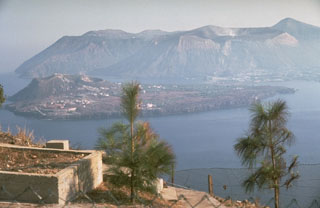Report on Vulcano (Italy) — January 1989
Scientific Event Alert Network Bulletin, vol. 14, no. 1 (January 1989)
Managing Editor: Lindsay McClelland.
Vulcano (Italy) CO2 in soil increases
Please cite this report as:
Global Volcanism Program, 1989. Report on Vulcano (Italy) (McClelland, L., ed.). Scientific Event Alert Network Bulletin, 14:1. Smithsonian Institution. https://doi.org/10.5479/si.GVP.SEAN198901-211050
Vulcano
Italy
38.404°N, 14.962°E; summit elev. 500 m
All times are local (unless otherwise noted)
CO2 concentrations in soil near Vulcano's summit crater increased substantially between measurements in October 1987 and November 1988 (table 1), correlated with increased fumarolic activity. Changes in concentrations and flow rates of CO2 gas have been correlated to volcanic activity by Elskens, Tazieff, and Tonai (1969).
Table 1. CO2 soil concentrations near Vulcano's summit crater, in mole %. Equipment, sites, and the person making the measurements were all identical for both data sets.
| Location | October 1987 | November 1988 |
| Flat crater bottom | 0.1 | 60-80 |
| N trail from bottom of rim | 0.1-0.5 | 10-40 |
| W and N rims | 0.1 | 7-22 |
| S and E rims | 1.6 | 4-30 |
Reference. Elskens, I., Tazieff, H., and Tonai, F., 1969, investigations nouvelles sur les gaz volcaniques: BV, v. 32, no. 3, p. 523-575.
Geological Summary. The word volcano is derived from Vulcano stratovolcano in Italy's Aeolian Islands. Vulcano was constructed during six stages over the past 136,000 years. Two overlapping calderas, the 2.5-km-wide Caldera del Piano on the SE and the 4-km-wide Caldera della Fossa on the NW, were formed at about 100,000 and 24,000-15,000 years ago, respectively, and volcanism has migrated north over time. La Fossa cone, active throughout the Holocene and the location of most historical eruptions, occupies the 3-km-wide Caldera della Fossa at the NW end of the elongated 3 x 7 km island. The Vulcanello lava platform is a low, roughly circular peninsula on the northern tip of Vulcano that was formed as an island beginning more than 2,000 years ago and was connected to the main island in about 1550 CE. Vulcanello is capped by three pyroclastic cones and was active intermittently until the 16th century. Explosive activity took place at the Fossa cone from 1898 to 1900.
Information Contacts: R.X. Faivre Pierret, DPT/SPIN/LESI CEA CEN, Grenoble, France; F. Le Guern, CNRS, CFR, CEN, Saclay, France.

